 |
||
|
||
| ||
Are you annoyed buying video cards which don't differ from each other at all? What some exotics? Is there any difference between brandname cards and cards from other manufacturers, beside the price of cause? Quality. And it's not only the production quality, but the quality of components. Two years ago the problems with cards from such manufacturers as AXLE, SuperGrace, Butterfly, Daytone, Innovision were quite standard - for little money you could purchase the cards not of high quality and performance. NVIDIA has solved the problem with the cards, based on its GPU, easily - all NVIDIA partners, which produce the cards on these chips, are getting a reference-design of the cards and the complete sets of the graphics processors and videomemory. In the end, almost all the GPU based boards from NVIDIA look similar to each other, differing only in price and a little in performance. Now you can choose any GPU based card from NVIDIA and you won't be disappointed with its speed and image quality. Nevertheless, one always wants something unique, but not overpriced and with appropriate performance. Today we managed to put our hands on cards from SUMA company from South Korea. SUMA stands for SuperMicro System. The company was founded in 1998 and at once it became an exclusive partner of AOpen. Later it concluded contracts with 3dfx (at that time it produced only Voodoo2 and Voodoo Banshee chipsets) and with NVIDIA (Riva TNT). In the end, SUMA received a widespread acceptance both in Korea and in other South-East Asia countries. And it's known even in the USA. Unfortunately, Europe doesn't know it. SUMA deals not only with video cards, it specializes in MP3-players, WEB-cameras etc. In our lab we have got 5 cards of Platinum series from SUMA. Two of them are based on GPU GeForce2 GTS, and the other three are on GPU GeForce2 MX. First we want you to take a look at the configuration of our testbed:
1. SUMA Platinum GeForce2 GTS SE (Special Edition) 64MBThe video card has AGP Pro interface (compatible with AGP 2x/4x), 64 MB DDR SDRAM from Hyundai located in 8 chips on the right side of the PCB. 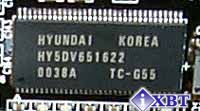 Note that the memory modules have 5.5 ns access time instead of 6 ns, as it's said in the specs for GeForce2 GTS based cards from NVIDIA. Consequently, the memory working frequency constitutes not 166 MHz, but 183 MHz (366 MHz). The main features of SUMA Platinum GeForce2 GTS SE (Special Edition) 64MB:
The card has an active cooler of unusual construction and large size. It should stimulate better cooling of GPU and good overclockability. However, the example of Leadtek WinFast GeForce2 GTS, which has also huge radiator, shows that it doesn't matter how strong the graphics processor gets cool - if it doesn't work at irregular frequencies, you can't help it. The PCB of black color has bright silvery letters of its name (and it's much more attractable than the samples with just a sticker with a model number. The card has a complete set of additional functions such as TV-out (on the daughter card), DVI interface. In the whole, there is everything from the reference design, what guarantees a reliable work and a full compliance with the parameters of NVIDIA for GeForce2 GTS based cards, but for AGP Pro slot. By the way, the video cards with AGP Pro works perfectly in AGP 2x/4x slots as well. The box for the card has quite an original design: I have never seen anything similar - such transparent plastic enclosures for video cards. In the box you can find the following:
OverclockingWith this card we managed to overclock the chip up to 225 MHz (unfortunately, the big radiator didn't help us to reach the higher frequency), the memory reached as much as 410 MHz (resulting). Taking into account that overclocking of the memory makes the greatest contribution to the performance gain for the video cards of this class, we can expect a considerable speed increase when running the card at unregular frequencies. Installation and driversSUMA ships reference drivers from NVIDIA of 5.33 version together with the video card. When testing we used the drivers of 6.47 beta version from NVIDIA. 2. SUMA Platinum GeForce2 GTS 32MBThe video card possesses AGP 2x/4x interface, 32 MB DDR SGRAM located in 4 chips on the right side of the PCB. Note that on the back side of the PCB there are some blank spaces for similar memory modules (that is, it's possible to manufacture 64 MB card on the base of this PCB). 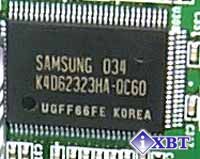 The modules from Samsung are set to 6 ns access time. The memory working frequency constitutes 166 MHz (333 MHz). The card has got a silvery active cooler of large size, just the same as SUMA Platinum GeForce2 GTS SE has. Unfortunately, as the previous example shows, a good cooling doesn't provide a good overclockability of the graphics core. The PCB is green with bright silvery letters of the name. The card is equipped not so substantial - there isn't neither TV-out nor DVI interface. In the whole, we can see that it follows the reference design in general, what ensures a reliable work. The box for the card has quite an original design: The complete set is similar to that of SUMA Platinum GeForce2 GTS SE (Special Edition) 64MB, but for the absence of a DVD-Video disc in this case. Overclocking225 MHz was the maximum graphics core frequency we could reach. As for the memory, it worked at 410 MHz, what is rather unusual for 6 ns. Installation and driversSUMA ships reference drivers from NVIDIA of 5.33 version together with the video card. When testing we used the drivers of 6.47 beta version from NVIDIA. 3. SUMA Platinum GeForce2 MX 32MBThis is the first card out of the whole series from SUMA, built on GPU GeForce2 MX. The card possesses AGP 2x/4x interface, 32 MB SDR SDRAM located in 4 chips on the right side of the PCB. 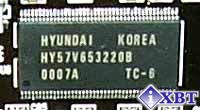 The access time of the modules is 6 ns; the modules are produced by Hyundai company. The memory working frequency is 166 MHz. The main characteristics of SUMA Platinum GeForce2 MX 32MB:
The card has an active cooler with a radiator of platinum color. The fact that the card has a fan is quite unusual, since even famous manufacturers install only a passive cooling radiator. The PCB is black with bright silvery name's letters. The manufacturer doesn't supply the model with TV-out and DVI interface. Note, that SUMA has developed its own design for GeForce2 MX based cards, declining the reference one. The video card ships in a box of legacy SUMA design: The complete set doesn't differ from that of SUMA Platinum GeForce2 GTS 32MB. OverclockingWith this card we could overclock the graphics core up to 220 MHz, the memory worked at 210 MHz as the highest. These are the typical values for the boards of GeForce2 MX class. Installation and driversSUMA ships reference drivers from NVIDIA of 6.18 version together with the video card. When testing we used the drivers of 6.47 beta version from NVIDIA. 4. SUMA Platinum GeForce2 MX Power Up 32MBThe card includes AGP 2x/4x interface, 32 MB SDR SDRAM memory located in 4 chips on the right side of the PCB. 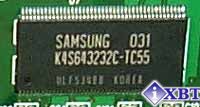 The access time of the modules is 5.5 ns; the modules are produced by Samsung company. The card differs from the previous one in the memory speed, which is higher here. The memory working frequency is 183 MHz. The card has an active cooler with a radiator of platinum color, similar to that of SUMA Platinum GeForce2 MX 32MB. But the construction is a bit different, the radiator is smaller, and the fan is a bit bigger. You can hope for a relatively good graphics core overclocking, though it's not so important because of a slow SDR-memory. The PCB is green with the same silvery letters of the name. As you can see, there is neither TV-out nor DVI-out. Once again, there SUMA company has established its own design. The card ships in the box of the traditional design: The complete set is similar to the previous sample. OverclockingMaximum graphics core frequency constituted 220 MHz, the memory worked at 210 MHz. Installation and driversSUMA ships reference drivers from NVIDIA of 6.18 version together with the video card. When testing we used the drivers of 6.47 beta version from NVIDIA. 5. SUMA Platinum GeForce2 MX SE (Special Edition) TwinView 32MBThe video card represents the third and the most interesting model of GeForce2 MX series. The card has AGP 2x/4x interface, 32 MB SDR SDRAM located in 4 chips on the right side of the PCB. 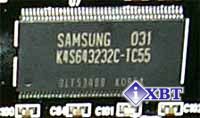 The access time of the modules is 5.5 ns; the modules are produced by Samsung company. The memory working frequency is 183 MHz. The card has just the same active cooler, as that of the previous model. The PCB is black with again bright silvery letters. The board incorporates a TV-out and the second VGA interface for the second CRT monitor. Pay attention to the chip of the second RAMDAC which is located a bit higher than the daughter board with a TV-out. The card has TwinView support. The card ships in the traditional box: The complete set is just the same as in the previous case. OverclockingMaximum graphics core frequency constituted 220 MHz, the memory worked at 210 MHz. Installation and driversSUMA ships reference drivers from NVIDIA of 6.18 version together with the video card. When testing we used the drivers of 6.47 beta version from NVIDIA. TwinViewThis technology from NVIDIA is very similar to DualHead from Matrox, but there is some difference in functionality. Here are the main ways of image output with TwinView activation:
Two imaging methods: Extended (desktop extension)
Desktop Clone
The quality of the image on the second display is rather good. Soon in a separate review we'll speak about TwinView technology in depth. Test resultsFirst comes 2D-graphics. In the previous articles we mentioned high quality and excellent speed in 2D which were shown by GeForce2 GTS and GeForce2 MX based cards from NVIDIA. All these cards received the results not worse than those of other boards of this class. I'm sure that the video cards from SUMA will provide for the majority with quality image. With the following 2 games we will consider speed level in 3D-graphics:
These tools are quite enough to show you the performance of the video cards when working via 2 main API. For you to compare, we give speed results of some other video cards:
Besides, we will show you the performance changes when in overclocking mode. NVIDIA GeForce2 GTS based video cards: 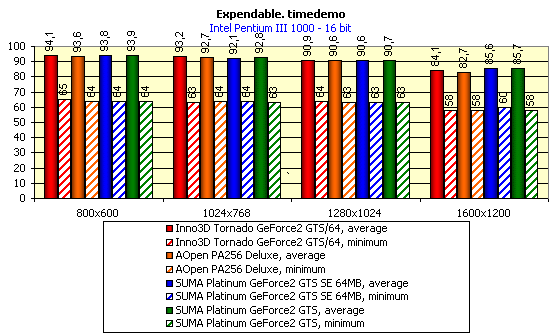 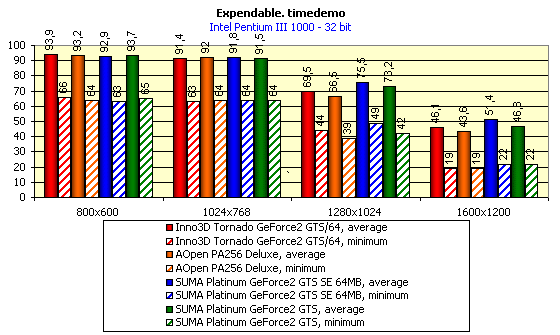 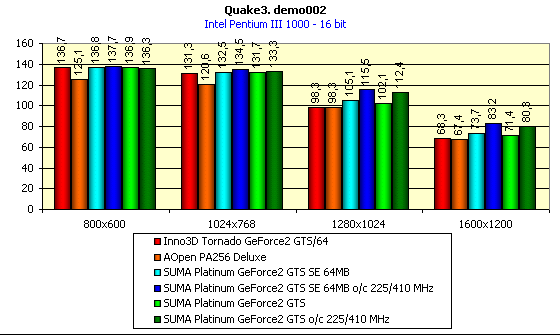 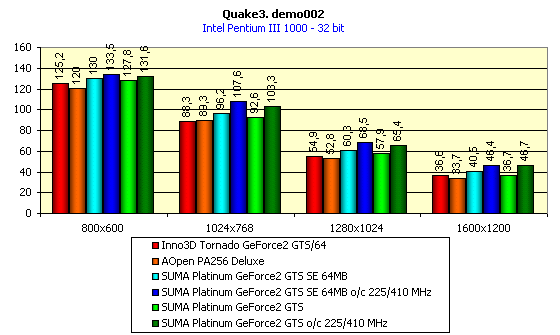 It's easy to see that SUMA Platinum GeForce2 SE 64MB video card has the best performance mark, it can be explained by the faster memory. The card SUMA Platinum GeForce2 32MB performed also quite good. In general, the results of the both cards correspond to the common level of their class. The highest performance gain is reached while overclocking. Note that the cards worked with just a little extra cooling (we installed only one additional fan in the system block). Of cause, you shouldn't generalize the results of this certain card to all cards of this series. NVIDIA GeForce2 MX based video cards: 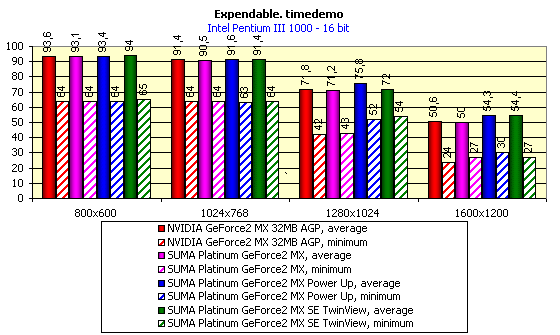 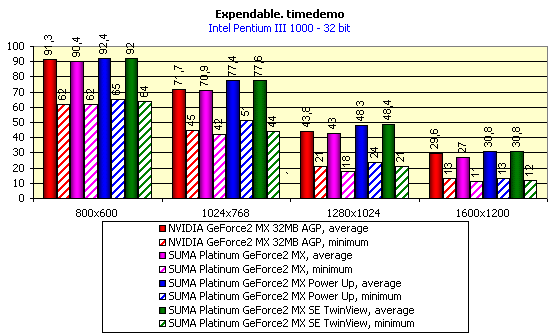 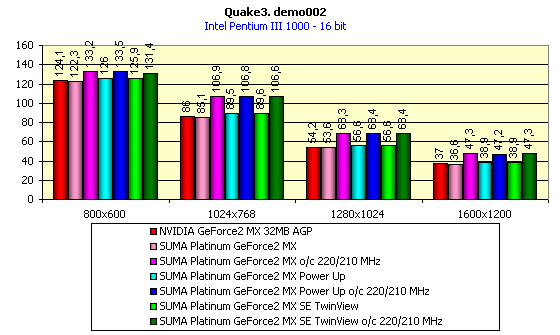 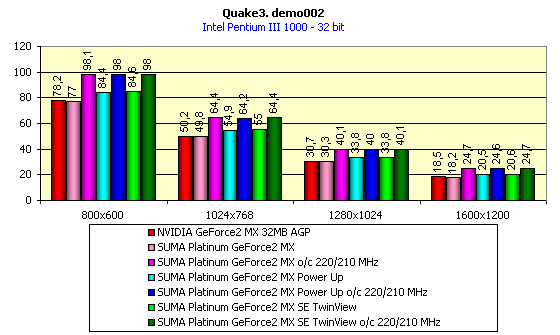 Similar to the previous tests, the performance of SUMA Platinum GeForce2 MX SE and PowerUp video cards is a bit higher than that of the contestants because of higher performance of the local memory. In the whole, the speed results comply with the average results of the boards of this class. ConclusionWe have covered the whole series of the video cards from SUMA (SuperMicro System). The tests reveal that these cards agree with our knowledge of the cards of this class in terms of quality and performance. SUMA products easily compete against the cards of such manufacturers as ASUS or Creative. SUMA cards have a unique design, a rich complete set and high quality. The price for SUMA production is low, however. For example, 32 MB card on GeForce2 GTS costs appr. $230, and GeForce2 MX based card costs $115. Highs:
Lows:
Write a comment below. No registration needed!
|
Platform · Video · Multimedia · Mobile · Other || About us & Privacy policy · Twitter · Facebook Copyright © Byrds Research & Publishing, Ltd., 1997–2011. All rights reserved. |